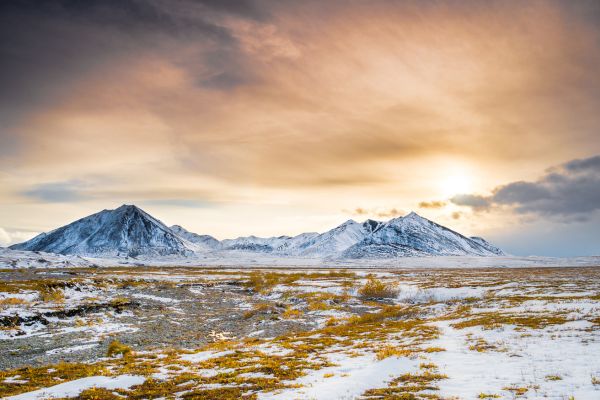
- Details
- By Darren Thompson
“With climate change warming the Arctic more than twice as fast as the rest of the planet, we must do everything within our control to meet the highest standards of care to protect this fragile ecosystem,” U.S. Secretary of the Interior Deb Haaland (Laguna Pueblo) said yesterday in a press release. “... The steps we are taking today further that commitment, based on the best available science and in recognition of the Indigenous Knowledge of the original stewards of this area, to safeguard our public lands for future generations.”
The Arctic National Wildlife Refuge was fast-tracked to permit drilling in 2020 under former President Trump’s Administration. Previously, the region had been protected for more than 60 years.
Haaland suspended the leases in June 2021, citing multiple legal deficiencies, including “insufficient analysis under the National Environmental Policy Act.”
At more than 19 million acres, the Arctic Refuge is the largest untouched land in the country and includes five different ecological regions: coastal marine, coastal plain tundra, alpine tundra, forest-tundra transition, and boreal forest.
The amount of oil under the Arctic National Wildlife Refuge is estimated at 11 billion barrels of oil, and many entities, including the Alaskan Congressional delegation and other state leaders, have lobbied for oil drilling in the region.
Protections for the National Petroleum Reserve in Alaska (NPR-A) include a ban on drilling and other industrial development in 13 million acres of the roughly 23 million acre area of public land managed by the U.S. Bureau of Land Management. The U.S. Department of the Interior (DOI) cited that Alaskan Native groups have occupied lands within the NPR-A since time immemorial, and more than 40 Indigenous communities rely on subsistence activities such as gathering food in the protected public lands.
The 13 million acres of additional protections are identified as Special Areas, or sensitive landscapes, per the Naval Petroleum Reserves Production Act (NPRPA) of 1976. They include the Teshekpuk Lake, Utukok Uplands, Colville River, Kasegaluk Lagoon, and Peard Bay Special Areas – places collectively known for their globally significant intact habitat for wildlife, including grizzly and polar bears, caribou and hundreds of thousands of migratory birds says DOI.
“The rule would establish an outright prohibition on any new leasing in 10.6 million acres, more than 40 percent of the NPR-A,” said DOI in yesterday’s announcement.
In March 2023, President Biden approved ConocoPhillips’ Willow Project, a massive and decades-long oil drilling venture on Alaska’s North Slope in the National Petroleum Reserve. The Willow Project is owned by the federal government and sits atop 600 million barrels of oil and would become the largest oil drilling project in U.S. public land.
Alaskan Rep. Mary Peltola, a Democrat who is the first Yup’ik person to serve in Congress, said in an interview with PBS News Hour that the project has consensus throughout the region and across Alaska and that the [Willow] project is “a good project.”
In a press release issued on Sept. 6, the Gwich’in Steering Committee, a local Indigenous-led organization that advocates for the protection of their way of life in the region, expressed concern about what is still yet to come in the region.
“We thank the Biden administration and the U.S. Department of the Interior for taking this step towards protecting the coastal plain and the Porcupine Caribou Herd, but we know that our sacred land is only temporarily safe from oil and gas development,” wrote the Gwich’in Steering Committee. “Our concern now is the SEIS [Supplimental Environmental Impact Statement] process and the mandated second lease sale in 2024.”
The Interior Department announced a 45-day public review and comment period on the draft SEIS for the Coastal Plain, which is the Coastal Plain Oil and Gas Leasing Program expedited by the Trump Administration. According to DOI, the Bureau of Land Management (BLM) and U.S. Fish and Wildlife Service engaged with a wide variety of stakeholders and used the best available data and science, including Indigenous Knowledge, in drafting the SEIS. To review the SEIS, go to the BLM’s website here.
More Stories Like This
Apache Leader Walks 60 Miles to Court Hearing That Will Decide Fate of Sacred Oak FlatRappahannock Tribe Raises Sovereignty and Environmental Concerns Over Caroline County Water Permit
Klamath Indigenous Land Trust Purchases 10,000 Acres as Salmon Return
Trump signs law that revokes some limits on drilling in Alaska’s National Petroleum Reserve
Southern Sierra Miwuk Nation Gets 900-Acres ofLand Back
Help us defend tribal sovereignty.
At Native News Online, our mission is rooted in telling the stories that strengthen sovereignty and uplift Indigenous voices — not just at year’s end, but every single day.
Because of your generosity last year, we were able to keep our reporters on the ground in tribal communities, at national gatherings and in the halls of Congress — covering the issues that matter most to Indian Country: sovereignty, culture, education, health and economic opportunity.
That support sustained us through a tough year in 2025. Now, as we look to the year ahead, we need your help right now to ensure warrior journalism remains strong — reporting that defends tribal sovereignty, amplifies Native truth, and holds power accountable.
 The stakes couldn't be higher. Your support keeps Native voices heard, Native stories told and Native sovereignty defended.
The stakes couldn't be higher. Your support keeps Native voices heard, Native stories told and Native sovereignty defended.
Stand with Warrior Journalism today.
Levi Rickert (Potawatomi), Editor & Publisher

